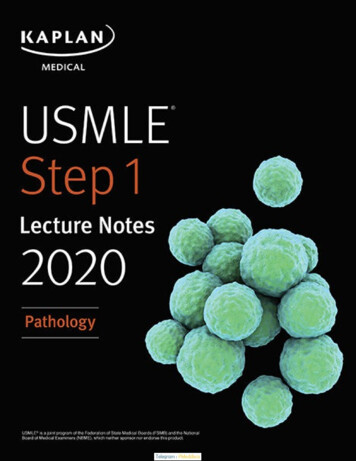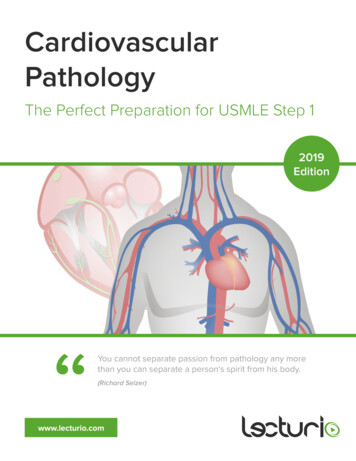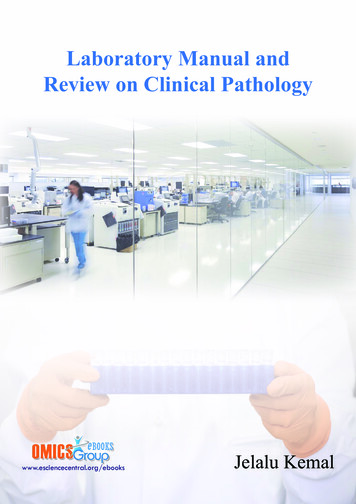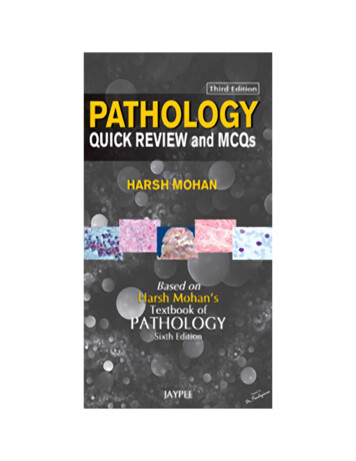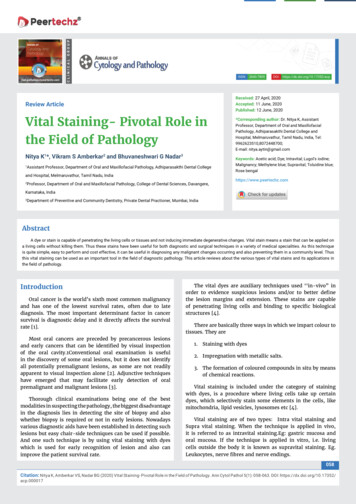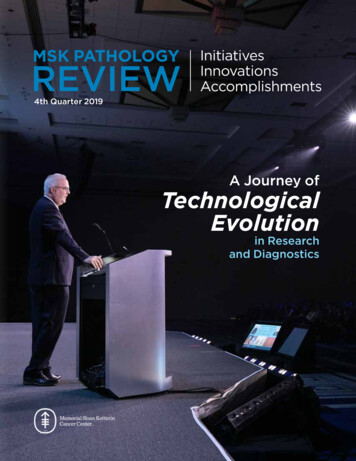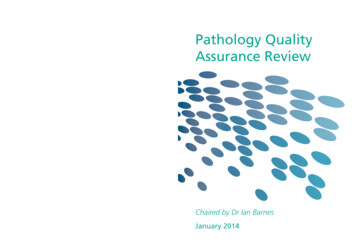
Transcription
Pathology QualityAssurance ReviewPathology Quality Assurance ReviewSkipton House80 London RoadLondon SE1 6LHengland.pathQAreview@nhs.netChaired by Dr Ian BarnesJanuary 2014
ContentsContents3Chair’s foreword41. IntroductionWhy the Review?Our approach6672. Understanding the existing system: the current assurance frameworkExternal quality assuranceAccreditationConclusion91112123. The need for changeClinical effectivenessLooking ahead: the changing nature of pathology in the NHSThe patient viewConclusion13131515164. The way forwardExpected outcomesTraining and development for qualityThe external quality assurance frameworkGovernanceError reporting and the sharing of learningInformatics and 17171822242628303234Case StudyCommissioning3636Membership of the Review Board38Thanks and acknowledgements383
Chair’s forewordDear Sir Bruce,You asked me to chair a Review to assess the current quality assurance frameworksand governance mechanisms for pathology services at a national level, makingrecommendations as to how any issues I uncovered could be remedied.This request in late 2012 followed an incident at Sherwood Forest Hospitals NHSFoundation Trust, subsequently one of the hospitals studied in your mortality review lastyear, where problems with quality assurance and an inadequate governance process wasreported to have negatively impacted upon the care of a number of women with breastcancer.Your ambition for quality assurance in pathology was to make it a benchmark againstwhich other services could measure their own success.As I have taken forward this Review, I have engaged extensively and am pleased toreport that I have found your ambition to be shared across the system, from Ministers topathology staff on the front line. I have also found consensus on areas for improvementwhich has allowed me to move beyond just making recommendations, to being in aposition to set out an agreed system-wide way forward.Pathology contributes to an overwhelming percentage of patient pathways, and only aservice that supports the rest of the system to make the best possible decisions abouttreatment can be acceptable to patients. In the light of Robert Francis’ Report of theMid-Staffordshire NHS Foundation Trust public inquiry, this means a service with arelentless focus on improvement, which champions the patient as a user and operates ina reflective and open manner, so that it can improve not only its own performance, butshare its learning to benefit the rest of the NHS. Pathology services should be reliable,robust and responsive, heeding your challenge to the NHS to “make quality our primaryconcern”1.In the course of this Review, the Review team and I have heard from a wide rangeof organisations and individuals, including a strong patient and public voice, layingout what is expected from pathology – a service which fundamentally informs clinicaldecisions about diagnosis and treatment – in terms of visibility, transparency, experience,communication, professionalism, reliability, safety, utility and contribution to the wideraims of NHS care.I have heard that, for the most part, NHS pathology services compare favourably withthe rest of Europe, and have multiple measures in place to ensure that the results theyproduce and the advice that they give is of high quality. The NHS in England boasts adedicated and highly skilled workforce, good internal quality assessment and qualitymanagement systems, and mature external assurance of its pathology services thatoverall provides a safe, reliable and effective service.1Review into the quality of care and treatment provided by 14 hospital trusts in England: overview report, July 20134
Chair’s forewordHowever, gaps exist. Elements of the system have become outdated. Quality must bescrutinised and made transparent, skills must be updated, and roles and responsibilitiesmust be formalised. Steps must be taken to ensure that patients are truly safeguarded,and a culture developed where any errors that do occur are made in an environmentprimed to detect and correct them, seeking constantly to improve clinical and workingpractices through continuous learning, sharing and innovation.It is important to note that, while the remit for the Review was for England, some of thechanges suggested will impact upon the devolved administrations. We have thereforeengaged with colleagues from Northern Ireland, Scotland and Wales, throughout thedevelopment of this report.With the energy, appetite and shared aspirations for pathology quality assurance Ihave come across throughout this Review, it is my hope that this report and the agreedactions it sets out will speak to the service, empowering individuals and organisations,both at the centre and at the front lines, to work together to make its ambition a reality.Yours sincerely,Dr Ian Barnes PhD, FRCPathChair, Pathology Quality Assurance Review5
1. Introduction1.1.Pathology lies at the heart of the NHS’s work. NHS pathology services inEngland employ around 33,000 people in over 150 organisations responding toapproximately 200 million requests a year, representing involvement in around80% of patient interactions with the NHS.1.2.The service routinely offers hundreds of different tests and investigations torequesting clinicians. Demand for tests has risen consistently as the NHS hasunderstood the contribution that pathology can make to better outcomes andlonger lives and patients and clinicians have consistently high levels of confidencein the service provided.1.3.This confidence is not without foundation: the UK has been at the forefront ofquality assurance in pathology for the past 50 years, leading the way on externalquality assurance. The UK was, along with Holland, the first European country tointroduce a laboratory accreditation scheme for pathology.1.4.However, the current system relies almost entirely on professionalism andgoodwill. It was set up to provide assurance to laboratories. It was not designedto provide public assurance to patients, nor to assist boards and commissioners infulfilling their statutory duties.1.5.Moreover, the current system is focused on minimal acceptable standards, andit does nothing to identify, incentivise or reward those who are striving forexcellence. Nor, it must be said, does it provide much in the way of sanctions orsupport when laboratories do fall below an acceptable standard of performance.1.6.We believe there is an appetite to improve and move towards aspirationalpractices at every level of the quality assurance system in pathology. Takenindividually, the changes suggested in this report are modest and achievable.They simply make better use of the processes we already have in place. But takentogether, these measures should ensure that pathology services are: visible to patientsaccountable to boards and commissionersreliable, robust, and responsiverewarded when they make improvements in quality, patient safety, and in thecontribution they make to patient experience held to account when they fail to offer the level of service patients expectWhy the Review?1.7.The current pathology quality assurance framework lacks several key factors:transparency, integration, scrutiny, oversight and effective triggers for rewardand sanction, without which we cannot say the best interests of patients andhealthcare generally are truly being served.1.7.1. The broad assurance framework has a lack of key assurance indicators(KAIs) to evidence quality and safety of pathology services, and to6
1. Introductionenable effective contract management both within organisations and bycommissioners.1.7.2. Pathology assurance and governance is not consistently embedded inprovider governance and assurance frameworks.1.7.3. Pathology is unable to provide evidence to the Care Quality Commission(CQC)/Hospital Inspectorate of the overall quality of pathology services.1.7.4. Pathology needs to respond to changing and additional requirements fromcommissioners and the public for information and assurance aroundconsistency of provision and reporting.1.7.5. The impact of new technology and processes (genomics, point of caretesting (POCT), digitalisation, molecular techniques, informatics) ondelivering pathology services, and the impact on a rapidly changingworkforce, require a strengthened quality assurance framework.1.7.6. There is too much variation between pathology services, and a lack ofharmonisation and standards, which is unacceptable to patients andusers.1.8.The current system was fit for the purpose for which it was designed, butit is not fit for the future, nor does it meet the emerging requirement fortransparency and well-evidenced quality assurance. Therefore, the Review and therecommendations it makes will attempt to bring these features of the system intosharper focus, strengthening existing structures to ensure these gaps are filled.Our approach1.9.The work of the Review was broad, covering a great number of facets and levelsof an already complex system. In order to best tackle this expansive area ofinvestigation a secretariat and a Review Board was appointed (members listed atthe back of this document), and the scope of work was divided into three tieredworkstreams, each with an expert lead. These workstreams looked at: Professional development, ie individual responsibilities Quality Assurance and Governance, ie provider and trust responsibilities The NHS national system, ie the responsibilities of national organisations1.10. In addition, Subject Matter Experts (SMEs), both individuals and agencies,contributed knowledge and expertise to undertake specific pieces of research andprovide detailed information and analysis of some of the technical and specialistareas within the scope of the Review.1.11. This included a survey of governance and culture with regards to pathologyQuality Assurance (QA), an investigation into representative error reportingpractice and attitudes, a large scale survey of aspects of roles and training for7
1. Introductionquality amongst pathology staff, a comprehensive stakeholder engagement andcommunications programme, and technical input on the progress with, andpotential for, standardisation of pathology data. Industry colleagues providedtheir perspective on how manufacturers can work with services to improve qualityand quality assurance, and a wide range of contributors from the profession, theprofessional bodies, the devolved administrations, the international community,statutory and third sector bodies and regulators have generously supported theReview with their time and expertise, allowing us to shape an holistic report thatattempts to address as many stakeholders’ interests as possible.1.12. In studying the current systems of pathology quality assurance, the Reviewfound much that was good. The professionalism, goodwill and commitmentof the staff involved in the management of quality assurance schemes shouldbe commended, as should the involvement of industry in the development andrapid diffusion of new technologies and process innovation. The professionalbodies play a vital role in the existing assurance framework, and provide strongleadership for the service. The work of the Chief Scientific Officer (CSO) andteam, with their recognition that the role of Healthcare Scientists is changing,has been visionary, and the efforts of the National Clinical Director (NCD) forPathology and the Pathology Programmes at the Department of Health (DH) andNHS England have created a solid foundation of physical and human resourcesfrom which to build a pathology service that bears comparison to the best in theworld.1.13. During our Review, we asked pathology services how they assured themselvesand their host organisations that their pathology service was safe, of highquality, and staffed by competent individuals. We received many submissionsfrom organisations involved in the quality assurance of the service. We askedpatients and commissioners what assurance they required, and what evidenceof compliance they wanted. We also met with CQC and considered how theassessment of the quality of pathology services might best be incorporated intothe CQCs new hospital inspection programme.1.14. We have arrived at a view that the current systems of quality assurance inpathology are no longer able to meet the needs of modern healthcare, and thedemand for greater transparency. Much of what is currently done is good andthe structures and organisations necessary to carry out the changes proposedalready exist. However, a redefinition of their scope and function is required, aswell as a number of initiatives to enhance the use of data and information alreadycollected. These themes form the basis of the recommendations of the Review.8
2. Understanding the existing system: the currentassurance framework2.1.Meaningful assurance has three main requirements. There must be a clearunderstanding of what the service should be achieving (specification, standards),there must be clear evidence of how assurance is being achieved (key indicators,measurement), and there must be clear consequences if assurance is not provided(corrective action, sanctions).2.2.The UK has been recognised internationally as being at the forefront of QA inpathology for decades, creating and running schemes that assure the qualityof individuals, processes and systems. These include External Quality Assurance(EQA) schemes (used by pathology services as a tool to test the competence ofindividuals and the reliability of tests and methods), and a national laboratoryaccreditation scheme. The professional bodies including The Royal College ofPathologists (RCPath), Institute of Biomedical Science (IBMS), Association forClinical Biochemistry and Laboratory Medicine (ACB) have taken the lead insetting professional standards.2.3.The framework that currently exists for governing, regulating and assuringthe quality of pathology services comprises a variety of assurance measures atdifferent levels of the system. This is illustrated in the diagram below:GJWGQA ernnanceDPathology ProviderInternal nFIEHB Professionalstandards unitsat ProfessionalBodiesCRegulation(GMC, HCPC)Pathology DirectorateFig 1: The above diagram gives a high-level view of the main roles of providers and laboratories, regulators,statutory bodies, commissioners, the accrediting body and professional organisations, in assuring the qualityof pathology services. Activities shown in green are internal to laboratories and providers. Activities shown inblue are external processes of assurance. Red arrows indicate lines of reporting, and dashed arrows representareas where this relationship exists in theory but is not extensively utilised. The nature of the relationshipsbetween the lettered boxes are indicated in the text below.9
2. Understanding the existing system: the currentassurance framework2.4.The hierarchical framework comprises a number of separate, independentprocesses. Within the pathology provider organisation (shown in green on figure1) there is a governance process for assuring both themselves and the executivemanagement that the services being provided are safe and of high quality(box A). This should include regular reporting of KAIs including error reporting,performance in external quality assurance programmes and internal qualitycontrol (IQC), accreditation status, and staff and technology issues.2.5.IQC is the responsibility of the provider and is required for every test performedacross all disciplines, providing assurance of the satisfactory performance ofa test on a day-to-day basis. In the Welsh External Quality Assurance Scheme(WEQAS) audit of IQC in 20132, wide variability in IQC programmes in bloodsciences across laboratories was revealed. Concern about the lack of appropriateIQC programmes in blood sciences has been expressed by diagnostic IVD (in vitrodiagnostics) providers, and also about the increasing loss of skilled scientific staffwith an understanding of quality control. IQC in microbiology and histopathologypose different and more challenging issues, since statistically based QA is notpossible.2.6.Medical and scientific staff in pathology are professionally regulated, statutorilyor voluntarily, through their registration bodies, eg the General Medical Council(GMC) and Health and Care Professions Council (HCPC) (box C). Professionalissues are also dealt with by the Professional Standards Unit (PSU) in the RCPath,including revalidation of medical staff, and the Education and ProfessionalStandards Committee at the IBMS (box B).2.7.Best practice examples exist where the provider organisation has an identifiedboard level director with responsibility for pathology governance. However, thisis not widespread. Provider governance processes vary from organisation toorganisation and, with a few exceptions, there is no visibility or transparencyof performance outside the organisation. In addition, there is limited use ofperformance measures/key performance indicators.2.8.In the commissioning framework, commissioners have a duty of care to ensureall commissioned services are safe and of agreed quality. There is little evidenceof commissioners agreeing a detailed service specification for pathology and ofcontract monitoring against the specification where regular governance reportsfrom the provider would be expected (box D). An example of regular governancereporting within the provider organisation and to commissioners is given at theend of this document.2.9.There are a number of statutory error reporting requirements for providers ofpathology services (box E), such as SHOT (Serious Hazards of Transfusion) in bloodtransfusion and Serious Incidents (SIs). The SHOT reports are reported nationally inregular reports. Analysis and actions in response to Serious Incidents (SIs) are the2National Audit of IQC Practice in UK Biochemistry Laboratories, 201310
2. Understanding the existing system: the currentassurance frameworkresponsibility of the provider organisation, but there is little visibility ortransparency nationally. Pathology departments are required to report errors/unsatisfactory performance of reagents and devices to the Medicines andHealthcare products Regulatory Agency (MHRA) who have responsibility forworking with the diagnostic industry to resolve problems. MHRA believe thereis an under reporting of these issues. There is no national definition of anerror within the laboratory, and there is wide variance in error reporting withinpathology providers.External Quality Assurance2.10. The external assurance framework (shown in blue on figure 1) is based on twomain systems, an EQA system and an accreditation process, run by the UnitedKingdom Accreditation Service (UKAS).2.11. EQA schemes play an important role in the quality management andimprovement processes of clinical laboratory services (box F). EQA schemeperformance should be assessed in the laboratory in conjunction with appropriateIQC programmes and procedures.2.12. EQA schemes are available for most of the tests available across all disciplines inpathology and they are provided by a number of different organisations. EQAschemes are technical and interpretative, the latter important in professionalopinion, rather than quantitative based diagnosis, as in histopathology. EQAschemes mainly focus on the analytical process and method performance, butin recent years there are also schemes for assessing individual performance ofclinical staff. The pre- and post-analytical phases (before a sample reaches thelaboratory, and from the point at which the test result is reported, respectively)are mainly outside of the scope of the schemes. The schemes are funded byindividual scheme subscription.2.13. Typically, a specimen (or slide) is sent to a laboratory and the laboratory shouldtreat the specimen as a patient sample and return a result to the schemeorganiser. This result is then assessed and compared with the overall resultsobtained from all participants and national reference materials. A report is issuedback to the laboratory indicating satisfactory/unsatisfactory performance. Allreported data is anonymised. There is inconsistency in schemes: for example, thefrequency of distribution of specimens is variable, typically monthly, but in somespecialist/small schemes it may be only 1-3 times a year. This means that for sometests, detecting poor performance by EQA returns can be a lengthy process.2.14. The definition of poor performance criteria may differ between EQA providers,and there are no internationally agreed performance standards or harmonisedcriteria across schemes. EQA schemes should be accredited by UKAS to ISOstandard 17043 but this standard only requires scheme providers to defineperformance criteria and laboratories are able to choose the scheme inwhich they wish to participate. Some schemes appear to be more exacting inperformance criteria than others. Participation in EQA schemes is voluntary, but isa requirement for UKAS accreditation.2.15. EQA schemes are governed by discipline-specific expert panels, National Quality11
2. Understanding the existing system: the currentassurance frameworkAssurance Advisory Panels (NQAAPs), which oversee the schemes and agreethe functioning and performance criteria for each scheme. When a laboratoryor individual performs poorly in EQA the provider works with them to improveperformance, but if the laboratory fails to engage with the advice process orto resolve the performance issue the EQA scheme reports the laboratory to therelevant NQAAP. If this escalation fails the NQAAP refers the matter to the JointWorking Group for Quality Assessment (JWGQA) (box G).2.16. The JWGQA is a multidisciplinary group within the RCPath, which overseesperformance in EQA schemes in the UK. It is comprised of discipline-specificprofessionals from the NQAAPs and has a chair appointed by the college. Itoversees and supports the NQAAPs and will work with failing laboratories. It hasno mandatory powers but will contact CEOs of provider organisations if they havea consistently poorly performing laboratory, and will report this to CQC (box H)and to UKAS.Accreditation2.17. UKAS has responsibility for two main accreditation processes, one for laboratories(ISO 15189) and the other for accrediting EQA schemes (ISO 17043).2.18. The UK was one of the first European countries to introduce a pathologyaccreditation scheme (box I). In recent years, European countries have started toimplement ISO 15189 as the accreditation standard. The UK is now adopting thisand is in a transition from the previous standards to the new standards. The newstandards recognise pre- and post-analytical responsibilities of a clinical laboratory,areas that are often not under the control of pathology.2.19. Most European countries, like England, expect laboratories to meet anaccreditation standard but this is not mandatory. There are exceptions (Germanyand France) where it is required for regulatory/licensing requirements. Additionallyin the USA, laboratories must meet standards defined in the Clinical LaboratoryImprovement Act (CLIA). Many countries have no accreditation process.2.20. Despite its non-mandatory status, accreditation is widely used, including by CQC,as a marker for quality of pathology services and there is an expectation in thesystem that laboratories should achieve this independent seal of approval.2.21. Quality assessment and assurance in pathology services has mainly focused onachieving accreditation status and acceptable performance in EQA schemes.This should be regarded as achieving the minimum acceptable performance, anddoes not encourage continual improvement where services should be striving forthe best achievable performance. The new ISO 15189 standard has increasedemphasis on continuous improvement, which should help to address this issue.Conclusion2.22. Overall the quality assurance framework in pathology lacks several key factorswithout which we cannot say the best interests of the patient are being served:transparency, integration, key assurance indicators, oversight and effectivetriggers for sanction and reward.12
3. The need for change3.1. The NHS defines quality as care that is effective, safe and provides as positive anexperience as possible for both patients and carers.3.2.We believe that a high quality pathology service is founded upon reliability,robustness and responsiveness. Quality pathology services are reliable – given theright question, they will provide the right answer. They are robust because theyare continually improving their processes in the light of experience. Finally, theyare responsive because they are capable of adjusting to the varied and changingneeds of patients and clinical users of all kinds, and embracing the rapidlychanging technology to enhance patient services.Clinical effectiveness3.3.Pathology has an impact across the whole end-to-end patient pathway andrequires a strong user/provider partnership. Improvement in clinical practice andhealthcare leading to improved clinical outcomes and patient experience willnot be achieved without high quality pathology services. Pathology is a clinicalservice and provides clinical advice as well as test results. The clinical effectivenessof pathology can be judged on its impact on clinical services and outcomes. Itrequires quality-assured pathology services and tests of proven clinical utility,which, if used optimally, improve patient management and clinical outcomes.3.4.Pathology quality assurance processes have mainly focused on the analyticalphase and until recently there has been little performance assessment of pre- andpost-analytical phases. Accreditation has focused on internal processes in thelaboratory, and not on the quality of what is produced as a clinical/testing service.There is a lack of measures for the clinical effectiveness of testing. However, thetransition to the new international standard ISO 15189 against which laboratorieswill be accredited will require an increased focus on pre- and post-analyticalassessment and clinical effectiveness.3.5.The RCPath has established a Clinical Effectiveness department and otherprofessional bodies eg ACB have clinical committees. The production ofguidelines, with a consistent and standardised approach to requesting, testingand reporting is a key function of these groups. Strong professional leadershipwill be required, with involvement in the evidence and evaluation of testeffectiveness, guidance on demand optimisation, measurements of KAIs, andaudit of clinical effectiveness.3.6.Examples of current good practice include the production of National Institutefor Health and Care Excellence (NICE) accredited microbiology standardisedinvestigations by the Standards Unit, Public Health England (PHE), and standardsfor transfusion produced by NHS Blood and Transplant (NHSBT). The Atlas ofVariation3 (2013) has illustrated the variation in direct access pathology testing inprimary care across England, due to local decisions and polices, and GP individualpreference. Benchmarking has for many years provided data to show the variationin efficiency and productivity of pathology services.3Diagnostics: The NHS Atlas of Variation in Diagnostic Services, November 201313
3. The need for change3.7.There is a need for a national approach by the professional bodies to produceagreed testing protocols which local laboratory services should implement toreduce this variation and promote more standardised testing for patients.3.8.Laboratories can improve the quality of the whole diagnostics cycle by increasingengagement outside the laboratory. For example, KIMMS (Key IncidentMonitoring and Management Systems) produced by the Royal College ofPathologists Australia provides a quality assurance service for the pre- and postanalytical phases.3.9.There is a role for the laboratory to proactively reach out and educate users. Asnew tests are introduced, redundant tests should be removed. New diagnosticmarkers for specific diseases will require more engagement with multi-disciplinaryteams managing patient pathways in both primary and secondary care settings.There is a need for a more proactive attitude to supporting and enabling POCTand digital solutions4. There is a lack of understanding by commissioners of thevalue of pathology and the opportunity for better utilisation of testing to impacton patient pathways. This can only be improved if the visibility of pathologyand direct engagement of users and patients with pathology professionals isimproved.3.10. Pathology is a key player in the patient pathway, and will be critical in deliveringwider improvements to NHS care, such as 7 day service provision. There areexamples (see below) of improving clinical effectiveness and changing clinicalpathways by implementing new approaches to pathology testing, though thesetend to be local, rather than nationally implemented, and dissemination anduptake nationally is often poor.Case study: Clinical EffectivenessDerby Hospitals Foundation Trust – Improving breast cancer treatment choicesby streamlining results from 15 to 1.91 days5Initiatives come in all shapes and sizes. Derby’s Histology initiative was relatively small; teamorientated; had clear clinical leadership; had specific aims and was effective in achieving animproved diagnostic service to our clinical users and ultimately patients. The aim was to shortenthe laboratory diagnostic pathway for specific cancer patients (Breast) by providing prognostichormonal results for the pre-operative multi-disciplinary team (MDT). Patients under go biopsy of asuspected malignant breast lesion and are discussed at MDT 3-5 days later where clinical decisionsare made regarding further treatment options such as surgery and chemotherapy. By having thehormonal
Pathology and the Pathology Programmes at the Department of Health (DH) and NHS England have created a solid foundation of physical and human resources from which to build a pathology service that bears comparison to the best in the world. 1.13. During our Review, we asked
